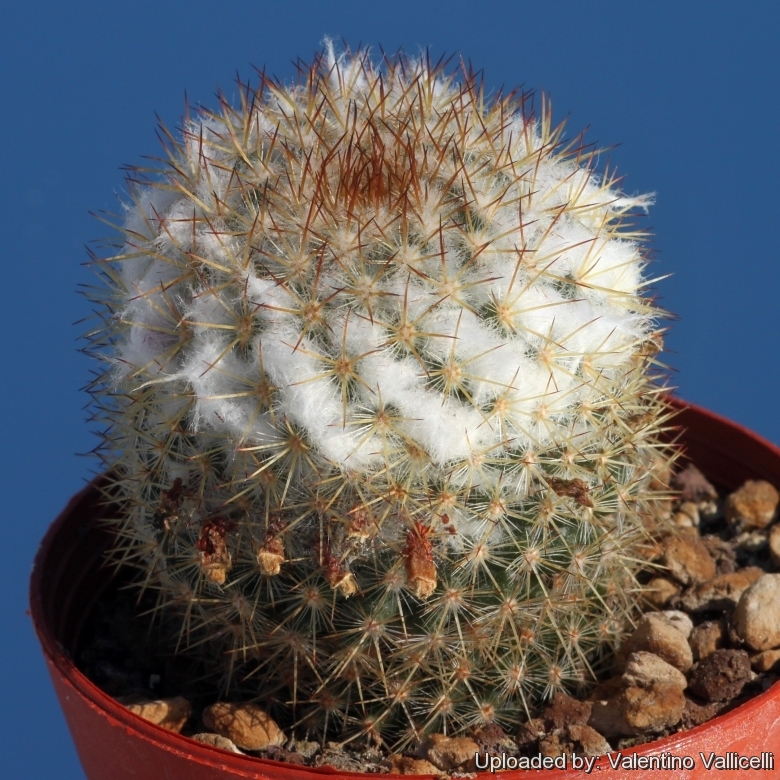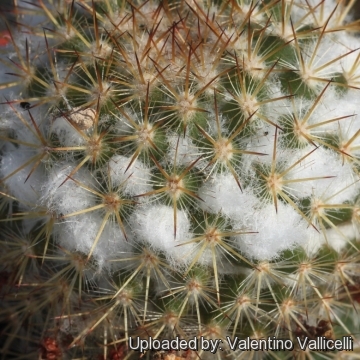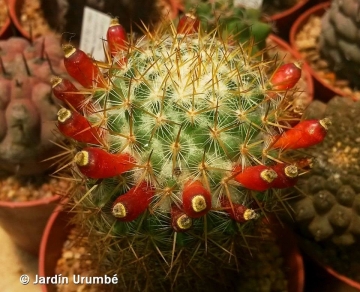
Mammillaria columbiana Photo by: Valentino Vallicelli
Origin and Habitat: Mammillaria columbianaSN|18469]]SN|18469]] grows in vast area that extend in central and south America with small isolated populations in low densities, comprising southern Mexico (Chiapas, Oaxaca, Yucatán), Honduras, Guatemala, Nicaragua, Panama, Jamaica, Colombia, Venezuela (Peru?)
Altitude: (0-)500 - 2150(-2800) metres above sea level.
Habitat: It grows in very small subpopulations on a wide range of habitats especially on rocky slopes and terraces slightly to very inclined and also along the shores of small rivers and canyons often on mossy rocks among sparse xerophytic shrubs and in open clearings in dry thorn forests. In most locations, it is known from a single individual or small subpopulations with no more than 50 individuals. In Chiapas, it is known from one locality. In Costa Rica, it is known from one locality. In the Yucatán, it is found on coastal dunes. In Costa Rica, it is found on a limestone outcrop in wet forest. Occasionally in some protected areas it grows along with Melocactus pescaderensisSN|31111]]SN|31111]] as an epiphyte plant on Prosopis juliflora. The seeds are dispersed by lizards. Although the species is not locally abundant, there are many locations so it is unlikely to be significantly affected by current threats throughout its range. Some of the subpopulations, particularly those in Mexico and Costa Rica, may be more at risk.
Synonyms:
See all synonyms of Mammillaria columbiana
Common Names include:
ENGLISH: South American pincushion
UKRAINIAN (Українська): Мамілярія колумбійська, Мамілярія колубіана
Description: Mammillaria columbianaSN|18469]]SN|18469]] is a mostly solitary or slowly offsetting cactus. Due to its ample diffusion it is extremely variable and for this reason it can be called the cactus of the “Thousand Faces”.
Stem: Narrow columnar stem, 8-25 cm tall, 5-18 cm broad.
Sap: Without latex.
Tubercles: Short conical.
Axil: Moderately woolly or densely woolly.
Radial spine: 18-20, bristle-like, white, 4-6 mm long.
Central spine: (3-)4-5(-7), golden yellow or greyish, needle-like, straight, 6-8 mm long.
Flower: Small that fail to fully open, bright red-pink, barely protruding from the wool.
Fruit: Club shaped, orange-red to purple.
Seed: Brown to glossy black, small, oval-rounded.
Subspecies, varieties, forms and cultivars of plants belonging to the Mammillaria columbiana group
Bibliography: Major references and further lectures
1) John Pilbeam (1999) “Mammillaria The Cactus File Handbook” page 74.
2) Edward F. Anderson (2001) “ The Cactus Family” page 412.
3) Sofía Albesiano, J.O.Orlando Rangel-Ch., Alberto Cadena “Vegetation of the Chicamocha River Canyon (Santander, Colombia)” Caldasia 25(1) 2003: 73-99
4) J.L. Fernandez-Alonso & G. Xhonneux Rev. Acad. Colomb. Cien. Exact. Fis. Nat. 26: 353-365. 2002;
5) J.L. Fernandez-Alonso & G. Xhonneux Cact. Aventures Int. 56: 2-15. 2002
6) Sofía Albesiano, & J.L. Fernandez-Alonso “Catalogue of the vascular plants from the Chicamocha river canyon (tropical zone), Boyacá-Santander, Colombia. First part” Caldasia 28(1):23-44. 2006
7) Nassar, J., Ishiki, M., Hammel, B., Hernández, H.M. & Durán, R. 2013. Mammillaria columbiana. The IUCN Red List of Threatened Species 2013: e.T152832A683935. http://dx.doi.org/10.2305/IUCN.UK.2013-2.RLTS.T152832A683935.en. Downloaded on 24 November 2016.
8) Albesiano, S. and Rangel, J.O. “Estructura de la vegetación del Cañón del Río Chicamocha, 500-1200m; Santander Colombia: una herramienta para la conservación”. Caldasia 28(2): 307-325. 2006.
9) Hunt, D. “Distribution records for Mammillaria columbiana”. Cactaceae Systematics Initiatives 24: 28-32. 2008.
10) Hunt, D., Taylor, N. and Charles, G. (compilers and editors). “The New Cactus Lexicon”. dh Books, Milborne Port, UK. 2006.
11) IUCN. “IUCN Red List of Threatened Species” (ver. 2013.2). Available at: http://www.iucnredlist.org. (Accessed: 13 November 2013). 2013.
12) Ponce, M. “Distribución de cactáceas en Venezuela y su ámbito mundial”. Facultad de Agronomia, Universidad Central de Venezuela. 1989.
13) Ponce, M. and Trujillo, B. “Distribution of wild Cactaceae in Venezuela according to different types of vegetation formations”. Ernstia 1(2): 79-88. 1991.
14) SEMARNAT. “Norma oficial mexicana NOM-059-SEMARNAT-2001, Protección ambiental - Especies nativas de México de flora y fauna silvestre - categorías de riesgo y especificaciones para su inclusión, exclusión o cambio - Lista de especies en riesgo”. Diario Oficial de la federación. 2002.
 Mammillaria columbiana Photo by: Valentino Vallicelli
Mammillaria columbiana Photo by: Valentino Vallicelli Mammillaria columbiana Photo by: Alexander Arzberger
Mammillaria columbiana Photo by: Alexander ArzbergerCultivation and Propagation: The Mammillaria columbianaSN|18469]]SN|18469]] is an easy to grow tropical Mammillaria, that doesn't take any frost.
Growth rate: It is a relatively rapidly growing and easily flowering species that will make clumps given the best conditions.
Soils: It likes very porous alkaline soil with a fair amount of organic matter.
Repotting: Use pot with good drainage.
Watering: Water regularly in summer, but do not overwater (Rot prone), keep dry in winter. However it needs more water than its Mexican relatives and seems to tolerate moisture around the roots somewhat better than most species.
Fertilization: Feed with a high potassium fertilizer in summer.
Hardiness: Tender. Avoid any frost. Reputedly sensitive to low temperatures, but less so if kept on the dry side prior to, and during, cold weather. Warmth throughout the year will increase the grower's success.
Exposition: Outside full sun or afternoon shade, inside it needs bright light, and some direct sun. Subject to sunburn if exposed to direct sun for too long. Tends to bronze in strong light, which encourages flowering and heavy wool and spine production.
Uses: It is an excellent plant for container growing. It always looks good and stays small. It look fine in a cold greenhouse and frame or outdoor in a rockery.
Pests & diseases: It may be attractive to a variety of insects, but plants in good condition should be nearly pest-free, particularly if they are grown in a mineral potting-mix, with good exposure and ventilation. Nonetheless, there are several pests to watch for:
- Red spiders: Red spiders may be effectively rubbed up by misting the vulnerable plants every day
- Mealy bugs: Mealybugs develop aerial into the new growth among the wool with disfiguring results, but the worst types develop underground on the roots and are invisible except by their effects.
- Scales: Scales are rarely a problem.
- Rot: it is only a minor problem with mammillarias if the plants are watered and “aired” correctly. If they are not, fungicides won't help all that much.
Warning: It has very sharp and hard spines. You should use gloves or wrap the cactus with thick newspaper. They may make it easier.
Propagation: Division, direct sow after last frost. Seeds germinate in 7-14 days at 21-27° C in spring. To make a cutting twist off a branch and permit it to dry out a couple of weeks, lay it on the soil and insert the stem end partially into the soil. Try to keep the cutting somewhat upright so that the roots are able to grow downward.












